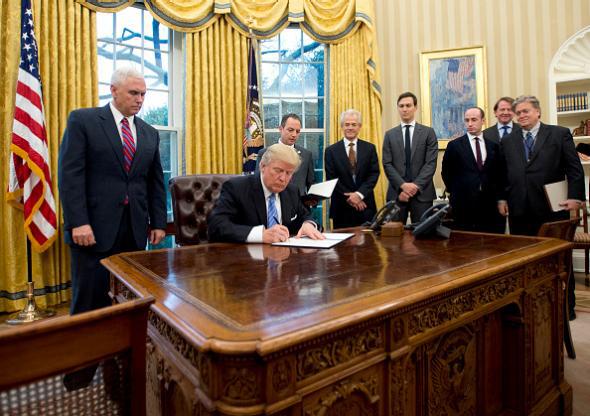
Ron Sachs/Pool/Getty Images
There’s a piece going around that identifies the Trump administration’s chaotic weekend rollout of a seven-nation Muslim ban as the “trial balloon” for a “coup” that would marginalize the legislative and judicial branches and consolidate all government power in the White House. While there were certainly disturbing reports over the weekend about executive branch employees ignoring judicial branch orders, this larger coup theory doesn’t entirely square with reality. A few of its problems:
- It speculates that green card holders (lawful permanent residents) were initially included in the ban as a ruse to intentionally “create chaos and pull out opposition,” i.e. provoke protests, with the ultimate goal of creating “resistance fatigue” in the general population. (White House chief of staff Reince Priebus said Sunday that the ban would not apply to green cards going forward.) But the early calls for protest against the ban didn’t mention green cards, and a number of the high-profile detentions that initially made headlines involved refugees rather than lawful permanent residents.
- It asserts both that the Department of Homeland Security (which includes border guards) is being groomed to become Trump’s loyalist personal security force and that some federal departments are being “deliberately hobbled” by orders that are “announced to them only after the fact.” Per the New York Times, though, one of the people that wasn’t told about the ban order until it was signed was John Kelly, Trump’s just-chosen leader of the Department of Homeland Security.
- It includes a reference to the infamous Christopher Steele dossier’s suggestion that Trump was offered a 19 percent stake in the Russian oil company Rosneft if he could lift sanctions on Russia, then notes that 19 percent of Rosneft was sold a few weeks ago. “The reason this is so interesting is that the dossier said this in July [2016], and the sale didn’t happen until early December [2016],” writes Yonatan Zunger, the coup theory’s author. But Vladimir Putin announced that 19 percent of Rosneft was for sale in December 2015. It doesn’t demonstrate any special knowledge on the part of Steele or his sources that he was aware of the 19 percent figure.
Generally speaking, the coup theory ascribes to 11-dimensional chess that which can be explained by simple incompetence and ideological extremism. Namely, the managerial incompetence of Donald Trump—recall that the only public company Trump ever ran lost money every year he was in charge and went bankrupt twice—and the ideological extremism of Steve Bannon and Stephen Miller, two of Trump’s top lieutenants.
Bannon is Trump’s “chief strategist” and the former publisher of the far-right site Breitbart; Miller was a senatorial aide to attorney general nominee Jeff Sessions before becoming Trump’s top speechwriter and is now a White House “senior adviser.” Bannon and Miller were reportedly the driving forces behind the ban, and both have histories that suggest they believe the United States should preserve a distinctly white culture through border control. Bannon has said publicly that he believes the “Judeo-Christian West” is in the “very beginning stages of a very brutal and bloody conflict,” a “global war” against Islamic terrorism; in the same speech, he praised “forefathers” who defeated Muslim armies in Europe. And there’s evidence that when Bannon says “Judeo-Christian” he actually means “white Christian”: His ex-wife said he didn’t want their daughters attending school with Jews while his site, Breitbart, has a section called “Black Crime” and has praised white supremacists like Richard Spencer who believe in the “natural” tendency toward racial segregation. (Bannon has denied his wife’s allegation.) And in a radio conversation with Trump in 2015 Bannon complained that too many Silicon Valley CEOs have Asian ancestry, which he said undermines American “civil society.”
Richard Spencer, for his part, says he was a “mentor” to Stephen Miller when Spencer was a Duke grad student and Miller was an undergrad. Miller denies this and says he “repudiate[s]” Spencer’s beliefs, but it is certain that Miller wrote columns for a campus publication denouncing the celebration of “Indian and Asian culture” at the expense of Thanksgiving and Christmas. (Miller himself is Jewish.) Another Duke conservative told Mother Jones, meanwhile, that one of Miller’s concerns about the United States was that “immigrants from non-European countries were not assimilating“; a June 2016 Trump speech that seems likely to have been written by Miller complained darkly that Muslim communities within the United States were sheltering terrorists. Slate’s Jim Newell saw Miller give a speech in Wisconsin in 2016 in which he complained that refugees were stealing local native-born Americans’ jobs; according to this report, refugees in Wisconsin predominately come from Nepal, Bhutan, Burma, Iraq, and Somalia. Miller is also largely responsible for the Trump campaign’s obsession with the idea that undocumented immigrants in the U.S. (who are predominately Latino) are unusually violent. (This does not appear to be empirically true.)
We know, in other words, that Trump’s aggressively degrading ban was designed by two men whose worldviews explicitly and implicitly treat nonwhite people—particularly Muslims—as a mass threat to the United States. That’s bad whether or not it’s part of a multiphase power play, and it’s happening right now. Why waste our time worrying about a bigger picture that may or may not exist?